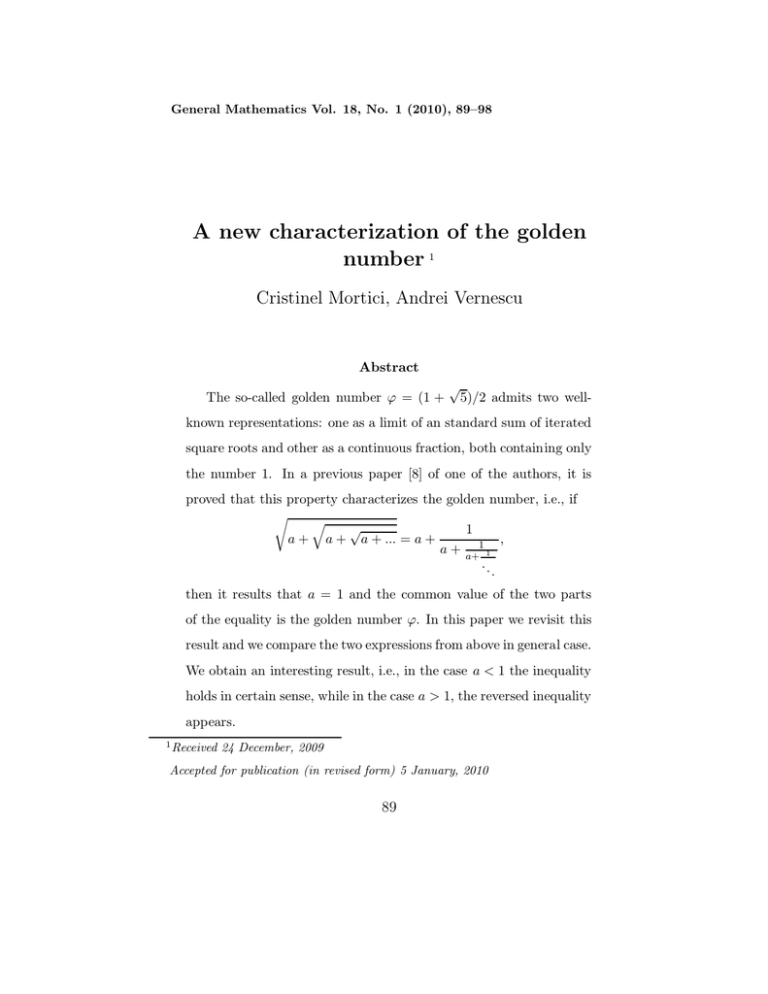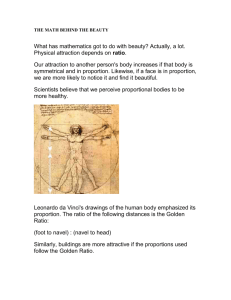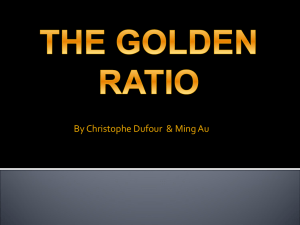A new characterization of the golden number Cristinel Mortici, Andrei Vernescu
advertisement

General Mathematics Vol. 18, No. 1 (2010), 89–98 A new characterization of the golden number 1 Cristinel Mortici, Andrei Vernescu Abstract The so-called golden number ϕ = (1 + √ 5)/2 admits two well- known representations: one as a limit of an standard sum of iterated square roots and other as a continuous fraction, both containing only the number 1. In a previous paper [8] of one of the authors, it is proved that this property characterizes the golden number, i.e., if r q √ 1 , a + a + a + ... = a + a + a+1 1 .. . then it results that a = 1 and the common value of the two parts of the equality is the golden number ϕ. In this paper we revisit this result and we compare the two expressions from above in general case. We obtain an interesting result, i.e., in the case a < 1 the inequality holds in certain sense, while in the case a > 1, the reversed inequality appears. 1 Received 24 December, 2009 Accepted for publication (in revised form) 5 January, 2010 89 90 C. Mortici, A. Vernescu 2000 Mathematics Subject Classification: 11A55, 11B39. Key words and phrases: Golden number, recurrence relations, convergence, Fibonacci’s sequence, Lucas’ sequence. 1 Introduction First, if consider only the structure as real number of the so-called golden √ number ϕ = (1 + 5)/2, then it is a quadratic algebraic number, being the greatest root of the equation ϕ2 − ϕ − 1 = 0, while the other root of this equation will be denoted by ϕ. However, the golden number consists the object of a very special attention, because of its interesting and useful properties, some of them given below: (i) the golden number appears in the division of a segment of length a in two parts of lengths u and v (u > v, u + v = a) such that u+v u = , u v which gives u/v = ϕ (from here it results also for ϕ the name of golden ratio). (ii) the expressions of the general term of the Fibonacci’s sequence (Fn )n≥0 and respective Lucas’ sequence (Ln )n≥0 defined by Fn+2 = Fn+1 + Fn ; F0 = 0 , F 1 = 1 Ln+2 = Ln+1 + Ln ; L0 = 2 , L 1 = 1 A new characterization of the golden number 91 √ involve ϕ and ϕ, namely Fn = (ϕn − ϕn )/ 5, respective Ln = ϕn + ϕn . (iii) Fibonacci considered the following (naive) model of the growth of a rabbit population. If it is assumed that the population starts having bunnies once a month after they are two months old; they always give birth to twins (one male and one female bunny), they never die and they never stop propagating. Then the number of rabbits pairs after n months is equal to Fn . The Fibonacci sequence is considered so important such that a special journal in pure mathematics is entitled ”The Fibonacci Quarterly”. It was founded in 1963 and appears as ”The official journal of the Fibonacci Association, devoted to the study of integers with special properties”. (iv) The golden number is closely related to the logarithmic spiral (see [2]). (v) The golden number is involved in a lot of results concerning the summations of some series, as √ 1 1 1 1 1 1 1 1 1 1 1 2 5 + − − + + − − + + ... = ln ϕ 1− − + 2 3 4 6 7 8 9 11 12 13 14 5 (see [1]), a beautiful illustration of a celebrated theorem of Riemann, or 1 1 1 1 1 + + + + + ... = 4 − ϕ F1 F2 F4 F8 F16 (see [5]). For proofs and other properties see for example [2] - [6], the journal [7] and the reference therein. All these mathematical properties as well as some properties in biology (we do not consider here also mystic, esoteric or aesthetic properties) explain the wide attention given to ϕ and these can be completed by the following two equalities: ϕ= r q √ 1 + 1 + 1 + ... 92 C. Mortici, A. Vernescu and ϕ=1+ 1 1+ 1 1+ 1 .. . (the first being in the rigourous sense that ϕ = lim xn , where n→∞ xn = s 1+ n radicals r q √ 1 + 1 + ... + 1 , while the second containing an usual continued fraction). Hence ϕ admits the most simple representation in terms of the numbers r q √ (1) x(a) = a + a + a + ... and (2) y(b) = b + 1 b+ 1 b+ 1 .. . with a = 1 and b = 1. In [8], the converse implication is proved, that is if a real number A admits the both representations (1) and (2) with the same parameter a = b, then a = b = 1 and A = ϕ. In other words, if r q √ 1 (3) A = a + a + a + ... = a + , a + a+1 1 .. . then a = 1 and consequently, A = ϕ. In the present paper we will give a new simple proof of the above result and in the last section we will compare the iterated radicals and the continuous fraction from (3) in general case a 6= 1. 93 A new characterization of the golden number 2 The second proof In [8] it is remembered the known convergence of the sequences xn (a) = s n radicals a+ r q √ a + a + ... + a and yn (b) = b + 1 (n − 1 fractions) 1 b+ b+ .. . + 1b using the Weierstrass theorem of bounded, monotone sequences. For sake of completeness, we will compute here the general term of the sequence (yn (b))n≥1 , using a nice idea of an adequate substitution and we will find also connections of that sequence with the Fibonacci’s sequence. We have the recurrence relation yn+1 (b) = b + 1 yn (b) or yn+1 (b)yn (b) = byn (b)+1. With the notation yn (b) = un+1 /un and u1 = 1, we obtain un+2 un+1 un+1 · =b· + 1, un+1 un un thus un+2 = bun+1 + un (note that in case b = 1, this is the recurrence from the Fibonacci’s sequence or from Lucas’s sequence). Further, if r12 = (b ± √ b2 + 4)/2 are the roots of the associated quadratic equation r 2 −br−1 = 0, 94 C. Mortici, A. Vernescu then we have un = λr1n + µr2n , where λ, µ are given by the system λr + µr = 1 1 2 . λr2 + µr2 = b 1 2 In consequence, after some easy computations, we deduce that √ √ (b + b2 + 4)n+1 − (b − b2 + 4)n+1 √ √ yn (b) = (b + b2 + 4)n − (b − b2 + 4)n √ and we see that the sequence (yn (b))n≥1 converges to (b + b2 + 4)/2. We can write that b+ 1 b+ = 1 b+ b+ 1 .. √ b2 + 4 . 2 . We have also from [8] that r √ q √ 1 + 4a + 1 . a + a + a + ... = 2 Remember that in [8] there are given two methods to prove that if r q √ 1 , a + a + a + ... = a + a + a+1 1 .. . then a = 1. Now we are in position to give a simpler proof of this result, by using a nice idea. To do this, assume that (3) is true. Then from r q √ A = a + a + a + ... it results that A = √ a + A and from a+ 1 a+ =A 1 a+ 1 .. . 95 A new characterization of the golden number it results that a + 1 = A. In consequence, A √ 1 A= a+A=a+ A and from here, the common value of a is (4) a = A2 − A = A − 1 . A In terms of A, we have A3 − 2A2 + 1 = 0 or (A − 1)(A2 − A − 1) = 0. The case A = 1 is not acceptable because it should attract a = 0 in (4). As A > 0, we derive A = ϕ, so we are done. 3 The main result We discuss here the more general case a 6= 1 in order to compare x(a) and y(a) given by (1)-(2). The answer to this problem, which also solve the result from [8], is given by the next Theorem 1 Let there be given a > 0. Then r q √ 1 a + a + a + ... > a + , for every a ∈ (0, 1) a + a+1 1 .. . q p √ 1 and a + a + a + ... < a + , for every a ∈ (1, ∞). a + a+1 1 .. . q p √ 1 In consequence, a + a + a + ... = a + if and only if a + a+1 1 .. . a = 1. 96 C. Mortici, A. Vernescu Proof. Here we denote by p and q the involved expressions: r q √ 1 (5) p = a + a + a + ... and q = a + , a + a+1 1 .. . 1 a + p, respective q = a + . Further, a = f (p) q 1 2 and a = g(q), where f, g : (0, ∞) → R are f (x) = x − x, g(x) = x − , x which can be viewed in the next figure. from which it results p = √ The graphs of the functions f and g meet at the point (1, 0) and (ϕ, 1) . As we can see from the above figure or as we can be easily prove, we have g(x) > f (x), for every x ∈ (1, ϕ) and g(x) < f (x), for every x ∈ (ϕ, ∞) . In our first hypotesis, we have a ∈ (0, 1) (on the Oy axis) then there exists an unique point p ∈ (1, ϕ) such that a = f (p) and there exists an unique point q ∈ (1, ϕ) such that a = g(q). More precisely, p and q are given by (5) and we have to prove that p > q. If we assume by contrary that p ≤ q, then, using also the monotony of the function f, we get the following contradiction: a = f (p) ≤ f (q) < g(q) = a. As we explained, p > q, thus from (5), the first assertion of the theorem is proved. A new characterization of the golden number 97 In our second hypotesis, we have a ∈ (1, ∞) (on the Oy axis) then there exists an unique point p ∈ (ϕ, ∞) such that a = f (p) and there exists an unique point q ∈ (ϕ, ∞) such that a = g(q). More precisely, p and q are given by (5) and we have to prove that p < q. If assume by contrary that p ≥ q, then using also the monotony of the function f, we get the following contradiction: a = f (p) ≥ f (q) > g(q) = a. As we explained, p < q, thus the proof is completed with (5). References [1] G.E. Andrews, R. Askey, R. Roy. Special Functions, Cambridge Univ. Press, 1999, 58-59. [2] S.R. Finch. Mathematical Constants, Cambridge Univ. Press, 2003. [3] M.C. Ghyka. Philosophie et Mystique du Nombre, Éd. Payot, Paris, 1952. [4] C. Hakenholz. Nombre d’Or et Mathématique, Chalagam Éd., Marseille, 2006. [5] R. Honsberger. Mathematical Games III, Math. Assoc. Amer., 1985, 102-138. [6] M. Livio. The Golden Ratio, Broadway Books, New York, 2002. [7] The Fibonacci Quarterly collection from 1963. [8] A. Vernescu. A Characterization of the Golden Section, or of the Constant of Fibonacci, Creative Mathematics, 13,2004, 27-30. [9] R. Vincent. Géométrie du Nombre d’Or, Chalagam Éditions, Marseille, 2007. Cristinel Mortici Valahia University of Târgovişte Department of Mathematics, Bd. Unirii 18, 130082 Târgovişte, Romania e-mail: cmortici@valahia.ro 98 Andrei Vernescu Valahia University of Târgovişte Department of Mathematics, Bd. Unirii 18, 130082 Târgovişte, Romania e-mail: avernescu@clicknet.ro C. Mortici, A. Vernescu






